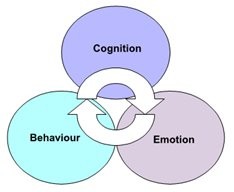Month 55
Behavior, cognitive, and other personal factors, and environmental influences all operate interactively as determinants of each other.

Brain research indicates that emotion and cognition are profoundly interrelated processes. Recent cognitive neuroscience findings suggest that the neural mechanisms underlying emotion regulation may be the same as those underlying cognitive processes.
Emotion and cognition work together, jointly informing the child’s impressions of situations and influencing behavior. Most learning in the early years occurs in the context of emotional supports. The rich interpenetrations of emotions and cognitions establish the major psychic scripts for each child’s life. Brain structures involved in the neural circuitry of cognition influence emotion and vice versa.
Emotions and social behaviors affect the young child’s ability to persist in goal-oriented activity, to seek help when it is needed, and to participate in and benefit from relationships. Young children who exhibit healthy social, emotional, and behavioral adjustment are more likely to have good academic performance in elementary school.
How I think @ 55 months
Now that your child sleeps through the night with no naps during the day, he can be a handful! During this critical phase, your child’s physical, cognitive, social, psychomotor and language development are substantially completed.
Motor Development: Gross Motor Skills
• I can bounce a ball to the wall so it hits floor once and then hits wall
• I can catch a ball with arms bent and using only hands
Motor Development: Fine Motor Skills
• I can copy a square. I can draw lines that are straight and within 15 degrees of vertical and horizontal, with closed corners
• I can build steps using 6 one-inch blocks after briefly seeing them in standing position (not observing how they were built)
Language and Thinking Development
• I can copy my own name!
• I can retell story from picture book with reasonable accuracy
Social and Emotional Development
• I understand rules of fair play
• I can accept mild, frequent teasing without becoming too agitated
• I wait for turn when playing in group games
• I select my own friends
• I have a best friend of same gender!
Activities
Disclaimer: This presents an overview of child development. It is important to keep in mind that the time frames presented are averages and some children may achieve various developmental milestones earlier or later than the average but still be within the normal range of development. This information is presented to help parents understand, at a high level, what to expect from their child. Any questions/concerns you may have about your child’s development should be shared with your doctor.




